Items
Tag
VAS
-
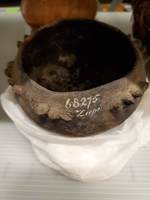 Cooking vessel This bowl is a rough ware style of pottery, made of a clay called Kuhn-kat-say. The spikes may have been used to represent the seedpods of Datura, a poisonous plant native to the Southwest. When administered in small doses, the plant causes hallucinations, perhaps purposely brought on for religious purposes.
Cooking vessel This bowl is a rough ware style of pottery, made of a clay called Kuhn-kat-say. The spikes may have been used to represent the seedpods of Datura, a poisonous plant native to the Southwest. When administered in small doses, the plant causes hallucinations, perhaps purposely brought on for religious purposes. -
 Bowl: bird symbols This Zuni stew bowl shows some of the unintended consequences of conservation. The adhesive, used to piece the bowl back together after it was broken, is now brittle and risks pulling slip and paint off of the body of the ceramic.
Bowl: bird symbols This Zuni stew bowl shows some of the unintended consequences of conservation. The adhesive, used to piece the bowl back together after it was broken, is now brittle and risks pulling slip and paint off of the body of the ceramic. -
 Bowl This Zuni bowl was likely used to serve stew, a communal dish. The design is geometric and patterned, including stepped designs and feather and crook designs.
Bowl This Zuni bowl was likely used to serve stew, a communal dish. The design is geometric and patterned, including stepped designs and feather and crook designs. -
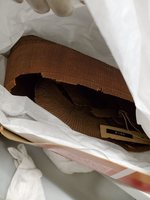 Basket This carrying basket has become extremely brittle and fragile over time. It is now difficult to hold without incurring further damage, but it would have originally been a useful tool for carrying goods.
Basket This carrying basket has become extremely brittle and fragile over time. It is now difficult to hold without incurring further damage, but it would have originally been a useful tool for carrying goods. -
 Basket This flat basket tray was woven from spruce root, with what appears to be a simple banded design for decoration. However, the reverse of the tray shows a more intricate, geometric design that has not been as affected by fading as the interior. It was collected by Mrs. L.C. Fletcher in Alaska, where it was likely sold by the artist as a means of generating income and supporting her family.
Basket This flat basket tray was woven from spruce root, with what appears to be a simple banded design for decoration. However, the reverse of the tray shows a more intricate, geometric design that has not been as affected by fading as the interior. It was collected by Mrs. L.C. Fletcher in Alaska, where it was likely sold by the artist as a means of generating income and supporting her family. -
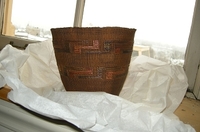 Basket According to the Sheldon Museum, baskets such as this would have been woven by women during winter months, when there was less harvesting and planting work to be done. The design is delicately woven into the basket to express the artist’s individual aesthetic sense.
Basket According to the Sheldon Museum, baskets such as this would have been woven by women during winter months, when there was less harvesting and planting work to be done. The design is delicately woven into the basket to express the artist’s individual aesthetic sense. -
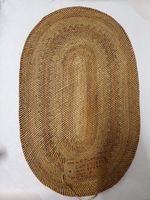 Mat This small mat was from a previously unknown tribe, but has been attributed to the Yakutat through Smithsonian records. It has been severely faded on one side, but is still bright and vibrant on the reverse.
Mat This small mat was from a previously unknown tribe, but has been attributed to the Yakutat through Smithsonian records. It has been severely faded on one side, but is still bright and vibrant on the reverse. -
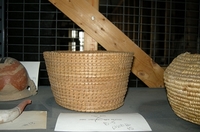 Basket This Pima basket was collected by L.C. Fletcher in Arizona. Its tight weave is still in excellent condition.
Basket This Pima basket was collected by L.C. Fletcher in Arizona. Its tight weave is still in excellent condition. -
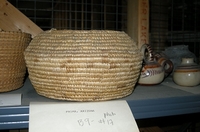 Basket This coiled basket was collected in Port Clarence, Alaska for the Interior Department Collection. Based on the location where it was collected, it was probably made by an Inupiat maker.
Basket This coiled basket was collected in Port Clarence, Alaska for the Interior Department Collection. Based on the location where it was collected, it was probably made by an Inupiat maker. -
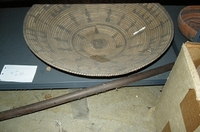 Basket This coiled basket tray was collected from the White Mountain Apache of Arizona by C. E. Bates. The design includes crosses, perhaps showing the influence of Christianity and colonization on the tribe.
Basket This coiled basket tray was collected from the White Mountain Apache of Arizona by C. E. Bates. The design includes crosses, perhaps showing the influence of Christianity and colonization on the tribe. -
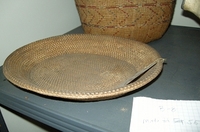 Basket This woven basket was collected for the Interior Department Collection in Alaska.
Basket This woven basket was collected for the Interior Department Collection in Alaska. -
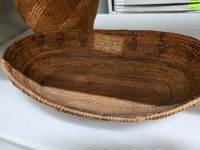 Basket This basket was purchased in Carson City, Nevada, by A.H. Fay. We have several pieces in the collection purchased there by Fay, suggesting that he frequented a shop of Indigenous art there.
Basket This basket was purchased in Carson City, Nevada, by A.H. Fay. We have several pieces in the collection purchased there by Fay, suggesting that he frequented a shop of Indigenous art there. -
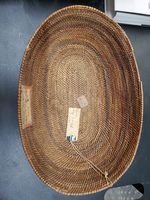 Basket This may be the only piece in the collection by a named maker. The tiny, faded tag may read “Minky, 12 y(ears old), Paiute squaw.” While we would today consider squaw to be a derogatory term for an Indigenous woman, it was used to market this basket when it was sold in Carson City, Nevada in 1916.
Basket This may be the only piece in the collection by a named maker. The tiny, faded tag may read “Minky, 12 y(ears old), Paiute squaw.” While we would today consider squaw to be a derogatory term for an Indigenous woman, it was used to market this basket when it was sold in Carson City, Nevada in 1916. -
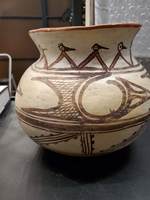 Jar-First Band-Conventional Bird This jar has an interesting design, with an upper band comprised of bird heads with geometric designs rather than bodies.
Jar-First Band-Conventional Bird This jar has an interesting design, with an upper band comprised of bird heads with geometric designs rather than bodies. -
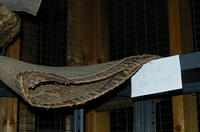 Mat This woven mat was collected from the Tsimshian tribe in Alaska. According to the Canadian Museum of History, the use of cedar-bark fiber for clothing and baskets distinguishes the Tsimshian from the Haida and the Tlingit, who favoured spruce-root fiber.
Mat This woven mat was collected from the Tsimshian tribe in Alaska. According to the Canadian Museum of History, the use of cedar-bark fiber for clothing and baskets distinguishes the Tsimshian from the Haida and the Tlingit, who favoured spruce-root fiber. -
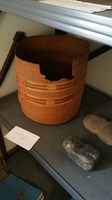 Basket We can tell that this is a Tlingit basket, rather than Haida, because the weaving jogs down to the right, a result of weaving the basket right side-up, as opposed to Haida weavers who weave the basket upside down, resulting in the stitches jogging up to the right.
Basket We can tell that this is a Tlingit basket, rather than Haida, because the weaving jogs down to the right, a result of weaving the basket right side-up, as opposed to Haida weavers who weave the basket upside down, resulting in the stitches jogging up to the right. -
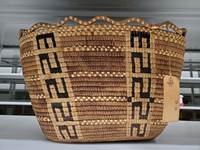 Basket This basket was collected from the Skagit River by L.C. Fletcher. It has a delicate decorative rim, which has come loose from the rest of the basket.
Basket This basket was collected from the Skagit River by L.C. Fletcher. It has a delicate decorative rim, which has come loose from the rest of the basket. -
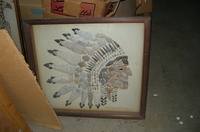 Indian points collection This mosaic image is formed from a collection of Indigenous arrow heads. The inscription notes that the arrowheads were collected, assembled, and mounted by Harry H. Perkins in 1936. Geology Professor C. K. Cabeen of Lafayette College purchased another arrowhead collection from Perkins the following year, and possibly collected this one at the same time.
Indian points collection This mosaic image is formed from a collection of Indigenous arrow heads. The inscription notes that the arrowheads were collected, assembled, and mounted by Harry H. Perkins in 1936. Geology Professor C. K. Cabeen of Lafayette College purchased another arrowhead collection from Perkins the following year, and possibly collected this one at the same time. -
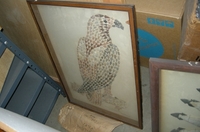 American Indian Bird Points (490) This mosaic image is formed from a collection of Indigenous arrow heads. The inscription notes that the arrowheads were collected, assembled, and mounted by Harry H. Perkins in 1937 for Geology Professor C. K. Cabeen of Lafayette College. Here, Indigenous objects were transformed from utilitarian hunting objects to an image that reflects the professor’s interest in collecting, stone, and education.
American Indian Bird Points (490) This mosaic image is formed from a collection of Indigenous arrow heads. The inscription notes that the arrowheads were collected, assembled, and mounted by Harry H. Perkins in 1937 for Geology Professor C. K. Cabeen of Lafayette College. Here, Indigenous objects were transformed from utilitarian hunting objects to an image that reflects the professor’s interest in collecting, stone, and education. -
 Basket This basket is a design commonly known as a Navajo wedding basket, which may be used in ceremonies to hold corn pollen. Today, designs like this are often made to be sold to tourists.
Basket This basket is a design commonly known as a Navajo wedding basket, which may be used in ceremonies to hold corn pollen. Today, designs like this are often made to be sold to tourists. -
Ladle This ladle was contaminated with arsenic, and thus has been less studied than other objects in the collection. It is more common for objects of organic material, such as woven baskets, to be contaminated, as arsenic was used as pest control in early museum practices.
-
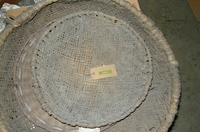 Yucca Basket This yucca sifter basket was collected from the Hopi tribe of Arizona. Sifter baskets are used by the Hopi to sift debris from food and for storage.
Yucca Basket This yucca sifter basket was collected from the Hopi tribe of Arizona. Sifter baskets are used by the Hopi to sift debris from food and for storage. -
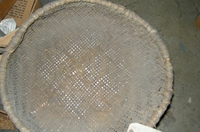 Yucca Basket This yucca sifter basket was collected from the Hopi tribe of Arizona. It was tagged by the U.S. National Museum, the forerunner to the Smithsonian museums.
Yucca Basket This yucca sifter basket was collected from the Hopi tribe of Arizona. It was tagged by the U.S. National Museum, the forerunner to the Smithsonian museums. -
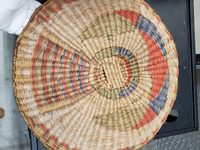 Meal tray This colorful basket was collected from the Hopi tribe of Arizona by Mooney, an anthropologist who worked extensively with Indigenous cultures. The basket depicts a kachina, or spiritual figure.
Meal tray This colorful basket was collected from the Hopi tribe of Arizona by Mooney, an anthropologist who worked extensively with Indigenous cultures. The basket depicts a kachina, or spiritual figure. -
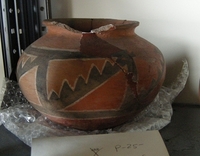 Jar This Hopi jar has severe damage, missing pieces that have broken off from the main body. Despite this, the jar has a vibrant painted design, with a bright red base and black geometric steps outlined in white. The design is simple, unlike the more intricate ones found on other jars in the collection.
Jar This Hopi jar has severe damage, missing pieces that have broken off from the main body. Despite this, the jar has a vibrant painted design, with a bright red base and black geometric steps outlined in white. The design is simple, unlike the more intricate ones found on other jars in the collection.